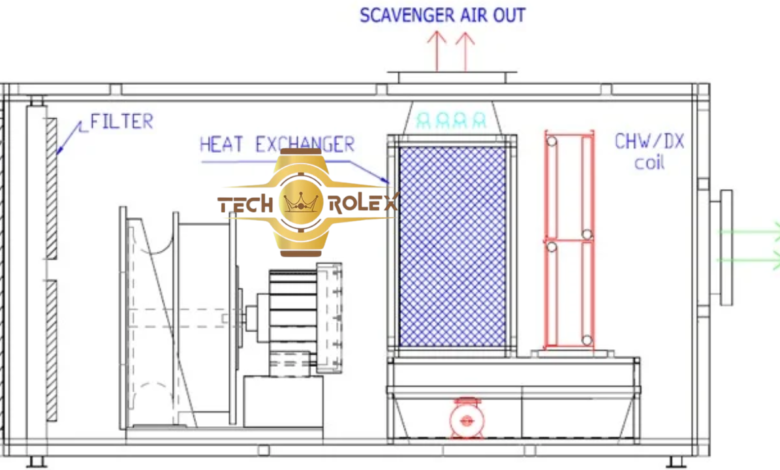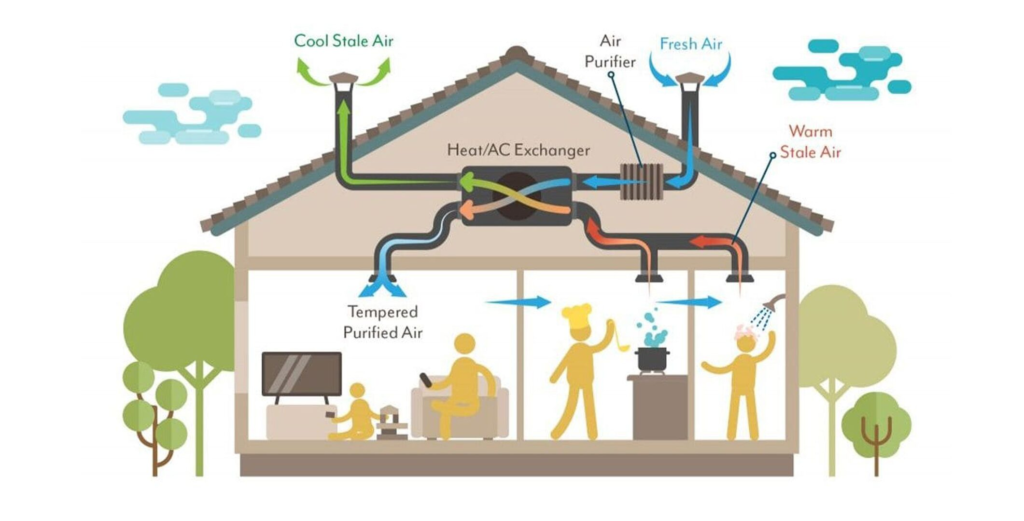What Is Treated Fresh Air? A Simple Guide for Everyone

Treated fresh air might sound like a technical term, but it’s really just about one thing: breathing clean, healthy air indoors. Whether you’re at home, at school, or in a hospital, the air you breathe can have a big impact on your health. Treated fresh air refers to outside air that is brought inside, cleaned, filtered, sometimes heated or cooled, and then circulated. It helps remove stuffy, stale air and replaces it with better-quality air. This process is often part of your HVAC system or a special device called an energy recovery ventilator (ERV). Treated fresh air improves indoor air quality, helps control moisture, reduces allergens, and makes our living and working spaces more comfortable and healthy. In this article, we’ll break everything down in simple terms—so even a 10-year-old can understand it.
Why Do We Need Treated Fresh Air Indoors?
Most people spend more than 90% of their time indoors. Whether we’re working, sleeping, cooking, or relaxing, we’re inside—and breathing air that’s been recycled over and over. Without proper ventilation or fresh air intake, this air becomes stale and full of pollutants like dust, odors, carbon dioxide, chemicals from cleaning products, and even airborne viruses.
Treated fresh air solves this problem by bringing in outdoor air, cleaning it, and adjusting it to a comfortable temperature. This is especially important in places that are sealed tightly for energy efficiency. Without treated fresh air, indoor environments can trap humidity and contaminants, leading to health issues like allergies, asthma, and even respiratory infections. By using a fresh air ventilation system, we keep the air moving and healthy to breathe.
How Does Treated Fresh Air Work?
Treated fresh air systems usually work as part of an HVAC setup or a separate fresh air ventilation system. Here’s how it works: outdoor air is drawn in through a duct called an outside air intake system. Before this air enters your living space, it passes through filters that trap dust, pollen, and harmful particles. Then, depending on the system, the air might be heated in winter or cooled in summer. Some systems use energy recovery ventilators (ERVs) or heat recovery ventilators (HRVs) to maintain energy efficiency while exchanging stale indoor air for clean outdoor air.
Once treated, the fresh air is distributed evenly throughout your space using ducts and fans. At the same time, stale indoor air is pushed out. This constant exchange of air keeps the environment clean, reduces moisture levels, and helps prevent the buildup of mold, VOCs (volatile organic compounds), and carbon dioxide.
Where Is Treated Fresh Air Used Most?
Treated fresh air isn’t just for fancy office buildings. It’s becoming more common in all kinds of buildings, especially as people become more aware of indoor air quality and its effects on health. Here’s a look at where treated fresh air systems are used most often.

In Homes and Apartments
Many modern homes are built to be energy efficient, meaning they’re sealed tight. While this helps keep heating and cooling costs down, it also means less natural ventilation. Treated fresh air systems like whole house fresh air systems, fresh air HVAC systems, and ERV systems for homes are being added to keep indoor air from becoming unhealthy. These systems are especially helpful for families with pets, allergies, or kids, as they reduce allergens, odors, and airborne bacteria.
In Hospitals and Clinics
Hospitals have some of the strictest indoor air standards. Here, mechanical ventilation systems with advanced filtration and sterilization features ensure that fresh air is continuously treated to prevent the spread of diseases. Air quality can literally be a matter of life and death in healthcare settings, and treated fresh air is a frontline defense against infection.
In Schools and Daycares
Children are more sensitive to poor air quality. That’s why many schools and daycares use treated fresh air systems to create a healthy learning environment. These systems help control carbon dioxide levels in crowded classrooms, reduce airborne illnesses, and keep students alert and focused. Proper fresh air intake systems are now part of new building codes in many states.
What Are the Benefits of Treated Fresh Air?
Treated fresh air offers a wide range of benefits—both for your health and your home’s structure. Here are some of the top advantages:
- Improves Indoor Air Quality: By bringing in fresh air and removing pollutants, treated fresh air systems improve air quality, making it easier to breathe and reducing respiratory issues.
- Reduces Allergens and Irritants: Dust, pet dander, mold spores, and pollen are filtered out, helping those with allergies or asthma.
- Controls Humidity: Proper ventilation keeps moisture levels in check, which prevents mold growth and damage to wood and walls.
- Reduces Odors and Stale Air: Cooking smells, smoke, and other unpleasant odors are carried away, leaving the home smelling fresh.
- Energy Efficiency: ERVs and HRVs recover heat or cooling from outgoing air, so you get fresh air without high energy bills.
- Better Sleep and Comfort: Clean, oxygen-rich air helps your body relax, improves sleep quality, and increases overall comfort.
With all these benefits, it’s easy to see why a home fresh air system is becoming a must-have feature in modern housing.
What Tools Clean and Treat Fresh Air?
There are several tools and systems used to treat and clean fresh air. Each plays a role in improving your indoor air quality:
- Energy Recovery Ventilator (ERV): This unit brings in fresh air while capturing energy from outgoing air to reduce heating and cooling loss.
- Heat Recovery Ventilator (HRV): Similar to an ERV, but focuses more on temperature exchange than humidity control.
- Air Filtration Systems: HEPA filters, activated carbon filters, and UV light filters trap or kill harmful particles in the air.
- Fresh Air Purifiers: These devices treat incoming air by removing contaminants and allergens.
- HVAC Fresh Air Intake Systems: These include ductwork and fans that connect your HVAC to the outdoors for consistent fresh airflow.
- Dehumidifiers and Humidifiers: These devices maintain proper humidity levels as air enters the home.
Each of these tools helps create an indoor air solution tailored to your home’s needs and your family’s health.
Can I Add Treated Fresh Air to My Home?
Yes, you can absolutely add treated fresh air to your home. Whether you live in an apartment, a single-family house, or a multi-story building, there’s a solution for your space. The key is to understand your current setup and then choose the right tools to improve it.

Check Your Current System First
Start by checking your existing HVAC system. Some newer units already have a fresh air intake built in. If not, see if there’s space for an add-on or if your system supports mechanical ventilation. You should also look for signs of poor air quality, like excess humidity, condensation on windows, or a musty smell.
Ask a Pro for Help
Hiring an HVAC professional is one of the best steps you can take. They can assess your indoor air quality, test your home’s airflow, and recommend a fresh air ventilation system that fits your needs. Professionals also make sure everything is installed correctly and safely, which is critical for long-term performance and comfort.
Choose the Right Equipment
Once you’ve evaluated your space, it’s time to choose the right system. This might include an ERV system for home, a fresh air HVAC add-on, or even a whole house fresh air system. Make sure the equipment fits your square footage, climate zone, and specific air concerns like allergies or humidity control.
Is Treated Fresh Air the Same as Ventilation?
Not exactly. While they’re closely related, treated fresh air is a specific kind of ventilation. Ventilation simply means moving air in and out of a space. This can be as simple as opening a window or using an exhaust fan. Treated fresh air goes a step further—it not only brings in outside air but also filters, heats or cools it, and controls humidity. So, while all treated fresh air is a form of ventilation, not all ventilation qualifies as treated fresh air.
The Bottom Line
Treated fresh air is one of the smartest and healthiest ways to improve your home or building. Whether you’re trying to reduce allergies, remove musty odors, or make your home more energy-efficient, treated fresh air delivers clean, filtered, temperature-controlled air exactly where you need it. It’s not just a luxury—it’s becoming a basic need in today’s tightly sealed, energy-efficient buildings.
From simple home fresh air systems to advanced ERV units in hospitals and schools, the technology has become more affordable and accessible than ever. With the right tools and a little planning, you can bring treated fresh air into your life and breathe easier every day. Clean air is not a privilege—it’s something everyone deserves. So whether you’re a homeowner, a parent, or just someone who cares about health, treated fresh air is a step toward a cleaner, safer, and more comfortable space.


